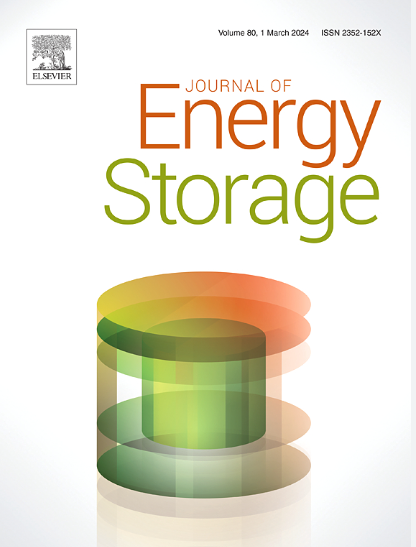Multi-walled Bi2O3/Bi@C particles as a high-performance anode material for lithium-ion batteries
IF 8.9
2区 工程技术
Q1 ENERGY & FUELS
引用次数: 0
Abstract
Bismuth (Bi) based materials possess an excellent volumetric capacity (3800 mAh cm−3), but their application is hindered by significant volume expansion and slow reaction kinetics during cycling. This study proposes a multi-walled strategy to synthesize multi-walled Bi₂O₃, effectively mitigating volume expansion during cycling. Building on this approach, we develop a multi-walled Bi₂O₃/Bi@C composite electrode, incorporating pseudocapacitance to further enhance its electrochemical performance. During subsequent charge-discharge cycles, the multi-walled Bi₂O₃/Bi@C composite electrode demonstrates satisfactory performance. At a current density of 0.5 A/g, it maintains a stable capacity of 280 mAh g−1 after 500 cycles, with a high energy density of 183 Wh/kg. Even at a current density of 1 A/g, the capacity remains stable at 180 mAh g−1 after 500 cycles. Through extensive cyclic voltammetry (CV), galvanostatic intermittent titration technique (GITT), and distribution of relaxation times (DRT) tests, we reveal the reaction kinetics of the composite. The results show a pseudocapacitive contribution of 75.62 % at a scan rate of 1.0 mV/s and a calculated Li+ diffusion coefficient (DLi+) ranging from 10−12 to 10−14 cm2/s. Furthermore, we identify six electrode reaction processes associated with solution resistance (Re), SEI film formation (Rs), charge transfer resistance (Rct), and ion diffusion resistance (Wo). This study provides new insights into developing high-performance and long-lasting Bi-based anodes for lithium-ion batteries.
作为锂离子电池高性能负极材料的多壁 Bi2O3/Bi@C 颗粒
铋(Bi)基材料具有出色的体积容量(3800 mAh cm-3),但其应用却受到循环过程中显著的体积膨胀和缓慢反应动力学的阻碍。本研究提出了一种合成多壁 Bi₂O₃的策略,可有效缓解循环过程中的体积膨胀。在此基础上,我们开发了一种多壁 Bi₂O₃/Bi@C 复合电极,并结合了假电容技术以进一步提高其电化学性能。在随后的充放电循环中,多壁 Bi₂O₃/Bi@C 复合电极表现出令人满意的性能。在 0.5 A/g 的电流密度下,它在 500 次循环后仍能保持 280 mAh g-1 的稳定容量,能量密度高达 183 Wh/kg。即使在电流密度为 1 A/g 时,经过 500 次循环后,其容量仍稳定在 180 mAh g-1。通过大量的循环伏安法(CV)、电静电间歇滴定技术(GITT)和弛豫时间分布(DRT)测试,我们揭示了该复合材料的反应动力学。结果表明,在扫描速率为 1.0 mV/s 时,伪电容贡献率为 75.62%,计算得出的 Li+ 扩散系数 (DLi+) 为 10-12 至 10-14 cm2/s。此外,我们还确定了与溶液电阻 (Re)、SEI 膜形成 (Rs)、电荷转移电阻 (Rct) 和离子扩散电阻 (Wo) 相关的六个电极反应过程。这项研究为开发高性能、长寿命的锂离子电池铋基阳极提供了新的见解。
本文章由计算机程序翻译,如有差异,请以英文原文为准。
求助全文
约1分钟内获得全文
求助全文
来源期刊

Journal of energy storage
Energy-Renewable Energy, Sustainability and the Environment
CiteScore
11.80
自引率
24.50%
发文量
2262
审稿时长
69 days
期刊介绍:
Journal of energy storage focusses on all aspects of energy storage, in particular systems integration, electric grid integration, modelling and analysis, novel energy storage technologies, sizing and management strategies, business models for operation of storage systems and energy storage developments worldwide.
 求助内容:
求助内容: 应助结果提醒方式:
应助结果提醒方式:


